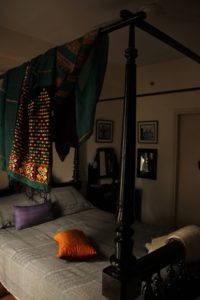Published 25 April 2019 ● Last Updated on 17 July 2020
This piece comes in time to commemorate Fashion Revolution – a movement born to demand fair wages and working conditions for workers-women in particular- in the garment industry. This movement was born in the aftermath of the Rana Plaza incident in Bangladesh on April 25, 2013 where thousands of garment factory workers perished and many others were badly injured.
Namaskaram!
After being a fashion writer and editor for over 15 years, and having written over 200 articles on the subject, I had an epiphany. I had no idea how many saris I had! Neither had I counted them nor had I given them a holistic thought. With a South Indian nativity, Army officer-dad-and-professor-mom’s upbringing across Indian states, and having spent the early-twenties and thirties life in four metros, my saris had multiple geographies. Some were carelessly tucked in metal trunks and almirahs back home in Bhubaneswar (Odisha); a few lived neglected lives in my mother-in-law’s wardrobe in Kolkata (West Bengal); while others hid in the dark corners of my closet in Gurgaon (Delhi-NCR).

Confession: When I took stock, they were over 100. And it took me over a year to manage this ‘inventory’. So, whenever I travelled back to my home turfs, I packed, sorted and tagged those loved-but-ignored drapes. I separated the saris—mine, my Amma’s (mom’s), and Ammamma’s (grandmother’s)—into three piles using the ever-famous 3Rs—Reduce, Reuse and Recycle—dictum. I named it the #saristrategy.

Tip: The key to kicking off this mammoth task was to act on my ‘Ichinen’ (a single moment of determination in Japanese, which is sort of comparable to Sanskrit word ‘Kshana’). Only then this act of decluttering became prompt and joyfully.
Why: Because my saris were and are intertwined with my individual cultural, psychological, spiritual and even physiological being. Disturbing their static existence strangely disoriented me dynamically. Yes, it worried me for a while. I was greedy, too. However, I did not give in or up. I kept at it to actualise the #rephilosophy that I had in mind. Now, it has been three years and I am still going strong with this plan. Here is a lowdown on how it has gone for me so far.

# R1 = Reduce
I was really ruthless. I piled those drapes that I did not like or ever wear into one lot. They were either gifts or on-a-whim buys. Mostly the former thanks to my ‘Telugu Brahmin’ lineage, which like many others in India is famously known for annual, festivity-based give-and-take. I dry-cleaned these ‘extras’ and generously gave them to my helps, and others in need. Later, I even crawled online to find authentic drop points, events, spaces, groups, people or places near me (to give them out at a later date).

A few examples that I came across from India back then were The Sareal Pact (by Payal Talreja and Anapoorni Trichur ), The Sari Library (by Ahmedabad-based architect and designer Vandana Agrawal of NGO Gramshree, which rents out occasional-wear saris), and Your Sari for Dignity (campaign by Goonj founders Anshu and Meenakshi Gupta. During this, I came across a Singapore-based event, as well The Timeless Appeal of the Indian Sari by Sarita Alurkar-Sriram and Sudha Kanago ). Next, I started keeping track of donation and CSR events (e.g. sari sale organised by Sahapedia, a New Delhi-based open online encyclopaedia on art, culture and history of India and Mission One Crore: Pledge a saree. Pledge a smile’ by e-commerce platform LimeRoad in association with Facebook & Goonj). Although I conveniently managed to miss these home-grown events, I reduced my first heap significantly thanks to women in my vicinity.

# R2 = Reuse:
I pumped in a lot of my creativity. I made my second pile of all old-but-loved saris (a few stunning Kanchipuram and Andhra silks from my trousseau) with their matching blouses. Next, I located a tailor in my area and got some ‘blah’ (read: ill-fitted) blouses altered to my taste. Note: If you live in Singapore, you could carry a bundle back to India and get them re-stitched here. For the saris I did not have or could not find any blouses; I chose a bunch of bodycon tops and boxy shirts to mix-and-match when needed. Then I lined-up a few neutral-coloured (black, grey, maroon, beige, white, navy, charcoal and the like) granny blouses off my Amma’s (mother’s) wardrobe into an Ikea box (helps me pick better in a hurry as I follow Marie Kondo’s roll-and-pack method of storing in it). These worked for on-the-go, random, contrast and officious-looking styling. It changed my perspective of wearing matching-matching all the time. As a result, a few block-printed and quirky blouses were the only ones I invested in (by picking up leftover fabric yardages from textile stores and getting them tailored to my taste). Last but not the least were the petticoats. Firstly, I pledged to stop buying matching ones. So, I ended up furtively slipping on a petticoat that was the closest shade to the sari I wanted to wear. I also took to standardising them by wearing neutral-coloured (say, black, white, beige, navy, maroon, grey and the like) ones with darker saris.

Sometimes, I even mustered up the courage to knot a heavy sari at my waist and give the inner layer a skip! All this helped me restyle each sari differently by only playing around with my myriad shoes, bags and jewellery. During the times I faced a ‘style block’, I Instagram-med my way out of it by following these awesome women, who mixed-and-matched either quirkily, beautifully or both. I love @winnynarayan, @sareesandstories, @sareepilla, @thebohobaalika, @life_in_a_saree and the likes. So, in a nutshell, here are my thumb rules: 1. Weave in bits of India into each look without fail 2. Incorporate as many borrowed, second-hand or hand-me-down vintage pieces from near and extended family, and friends. 3. Style optimally without blindly following fads off the Net or magazines (take inspiration only). 4. Stay true to my identity (what I am), and balance it with persona (what I project) and image (what others see me as). Voila! I had a new-ish sari wardrobe on a shoestring budget.
Victory: Now I have less than 30 saris that I wear quite regularly.

# R3 = Recycle:
I find this an ongoing spiritual, mindful and tangible act. I realised that my practical clothing needs are mostly dictated by my daily activities. My mornings (like that of many others) start early with domesticities followed by me-time—cooking, off-to-school preparations, Nichiren Buddhism chanting, yoga and pranayama. Late mornings and early afternoons, I live in an absolute work zone—tactile, digital, dynamic and creative—a few kilometres away from home. Early evenings and late evenings are packed with parenting and family to-dos. Nights roll into lounging, reading, resting and self-healing energy work of Reiki. While weekends are invariably a chaotic mix of comfort-seeking, social activities and sometimes short escapades.

This helped me state the obvious-yet-unobvious—almost all my mundane-need garments ought to be free-flowing and versatile, but not necessarily branded or new! Which means I was buying specific clothes for specific needs a lot more than needed. So, I started recycling and upcycling my underused, ordinary saris (just multiply your number of underused sari 5.5 meters of fabric each) into every day wear to fill this gap.

Core: Each RE piece I designed and stitched myself metamorphosed and blended into my existing wardrobe of newer styles. I started visualising saris geometrically more and more to design patchworked saris, wrap skirts, cocoon dresses, tunics, kaftans, stoles, pyjamas, drop-crotch pants, and the likes to suit my regular activities. While doing this I kept my geography, climate and anatomy in mind by reading up about ancient Vedic (Indian) philosophies like Hindu Luni-Solar Calendar (Rituvu) and Yoga. So, this meant fewer plush unnatural fabrics, heavy decorations or synthetic closures. This reduced the number of clothes I wore, changed, washed and maintained in a day, too. Soon I went old-world and minimal in my occasional wear. I wore my silk saris as often as I could (even internationally national clothing is considered formal). And a few saris I decided to repurpose into structured shapes that I could mix-and-match with my other ‘good’ styles.

Aftermath: Now, style guides me more than fashion. I buy new clothes only about once or twice a year. This buying is almost always NEED-based not WANT-based. I more or less have a contained wardrobe of overlapping winter and summer wear. Most of it is Vedic, natural, roomy, irregular, and climate-based. I am reverential of this huge shift in my thinking. And it is gently goading me more towards zero waste and spiritual living when it comes to clothing. Although, I still have a long, long way to go, I am hopeful of continuing this life-changing transition.
Sathya Bhavana is an India-based fashion writer/editor and the founder of Indian Slow Fashion Label Revastra ( @re_vastra). It tells nostalgic and spiritual fabric tales by redesigning or repairing saris of and for fearlessly creative individuals. The design aesthetic (#rephilosophy) is a mix of three concepts Vedic, Zen and Zerowaste. The label’s workshops encourage sari wardrobe management and mindful hand stitching / crafting using 3Rs+3Ps (#saristrategy).
Photographs taken by Amrita Haldipur



0 Comments